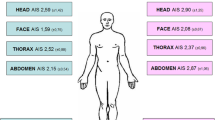Abstract
Pneumopericardium (PPC) describes the collection of gas in the pericardial sac. In tension Pneumopericardium (tPPC), this collection of gas may lead to cardiac tamponade. PPC following blunt trauma is considered a rare finding, as reflected by the low number of case reports on the topic. We analyzed the prevalence and pathophysiology of PPC and the associated trauma in 44 cases of falls from height. We retrospectively analyzed postmortem CT data and autopsy reports of fatal falls in the period March 2014–2017. A valid estimation of the height of the fall and a documented impact on an even and hard surface were inclusion criteria. A total of 44 cases were included in the study. We identified PPC in 18 of the 44 cases, and it was associated with an increased height of the fall, alongside aortic, pericardial, and myocardial ruptures. All cases with PPC also presented with bilateral pneumothorax. Five cases presented with a “ballooning” pericardium, indicating tPPC. PPC is a common finding in cases of falls from great heights. Due to a significant correlation with height and thus impact severity, PPC may be used as a reconstructive element in medico-legal investigations. Association with trauma makes PPC a sign of severe thoracic injury in postmortem and clinical radiology.



Similar content being viewed by others
References
Bricheteau M. Observation d'hydro-pneumo-pericarde, accompagnee d'un bruit de fluctuation parceptible a l'oreille. Arch Gener Med. 1844;4:334–9.
Adcock J, Lyons RH, Barnwell J. The circulatory effects produced in a patient with pneumopericardium by artificially varying the intrapericardial pressure. Am Heart J. 1940;19:283–91.
Cummings RG, Wesly RL, Adams DH, Lowe JE. Pneumopericardium resulting in cardiac tamponade. Ann Thorac Surg. 1984;37:511–8.
Capizzi PJ, Martin M, Bannon MP. Tension pneumopericardium following blunt injury. J Trauma. 1995;39:775–80.
Stegmaier J, Kirchhoff C, Biberthaler P, Buhmann S, Körner M, Ladurner R, et al. Spannungspneumoperikard als seltene Komplikation bei schwerem Polytrauma. Unfallchirurg. 2006;109:245–50.
Ladurner R, Qvick LM, Hohenbleicher F, Hallfeldt KK, Mutschler W, Mussack T. Pneumopericardium in blunt chest trauma after high-speed motor vehicle accidents. AmJ Emerg Med. 2005;23:83–6.
Haan JM, Scalea TM. Tension pneumopericardium: a case report and a review of the literature. Am Surg. 2006;72:330–1.
Gould JC, Schurr MA. Tension pneumopericardium after blunt chest trauma. Ann Thorac Surg. 2001;72:1728–30.
Van Peteghem S, Gevaert S. Tension pneumopericardium after blunt chest trauma. Acta Cardiol. 2015;70:83.
Gerard I, Verhelst D. Pneumopericardium. Lancet. 2002;360:771.
Roth TC, Schmid RA. Pneumopericardium after blunt chest trauma: a sign of severe injury? J Thorac Cardiovasc Surg. 2002;124:630–1.
Marques AFR, Lopes LH, dos Santos Martins M, Carmona CV, Fraga GP, Hirano ES. Tension pneumopericardium in blunt thoracic trauma. Int J Surg Case Rep. 2016;24:188–90.
O'Connor JV, Scalea TM. Tension pneumopericardium after blunt thoracic trauma. Ann Thorac Surg. 2010;90:1713.
Gorecki PJ, Andrei VE, Schein M. Tension pneumopericardium in chest trauma. J Trauma. 1999;46:954–6.
Ajdacic-Gross V, Weiss MG, Ring M, Hepp U, Bopp M, Gutzwiller F, et al. Methods of suicide: international suicide patterns derived from the WHO mortality database. Bull World Health Organ. 2008;86:726–32.
Huang X, Hinze J. Analysis of construction worker fall accidents. J Constr Eng Manag. 2003;129:262–71.
Risser D, Bönsch A, Schneider B, Bauer G. Risk of dying after a free fall from height. Forensic Sci Int. 1996;78:187–91.
Weilemann Y, Thali MJ, Kneubühl BP, Bolliger S. Correlation between skeletal trauma and energy in falls from great height detected by post-mortem multislice computed tomography (MSCT). Forensic Sci Int. 2008;180:81–5.
Petaros A, Slaus M, Coklo M, Sosa I, Cengija M, Bosnar A. Retrospective analysis of free-fall fractures with regard to height and cause of fall. Forensic Sci Int. 2013;226:290–5.
Westaby S. Penumopericardium and tension pneumopericardium after closed-chest injury. Thorax. 1977;32:91–7.
Macklin CC. Transport of air along sheaths of pulmonic blood vessels from alveoli to mediastinum: clinical implications. Arch Intern Med. 1939;64:913–26.
Mirvis SE, Indeck M, Schorr RM, Diaconis JN. Posttraumatic tension pneumopericardium: the" small heart" sign. Radiology. 1986;158:663–9.
Winklhofer S, Berger N, Ruder T, Elliott M, Stolzmann P, Thali M, et al. Cardiothoracic ratio in postmortem computed tomography: reliability and threshold for the diagnosis of cardiomegaly. Forensic Sci Med Pathol. 2014;10:44–9.
McDougal CB, Mulder GA, Hoffman JR. Tension pneumopericardium following blunt chest trauma. Ann Emerg Med. 1985;14:167–70.
Leth PM, Struckmann H, Lauritsen J. Interobserver agreement of the injury diagnoses obtained by postmortem computed tomography of traffic fatality victims and a comparison with autopsy results. Forensic Sci Int. 2013;225:15–9.
de Bakker HM, Soerdjbalie-Maikoe V, Kubat B, Maes A, de Bakker BS. Forensic imaging in legal medicine in the Netherlands: retrospective analysis of over 1700 cases in 15 years' experience. J Forensic Radiol Imaging. 2016;6:1–7.
Berner O. Ein Fall von “Pneumopericardium”. Virchows Archiv für pathologische Anatomie und Physiologie und für klinische Medizin. 1937;299:750–3.
Gebhart FT, Brogdon B, Zech W-D, Thali MJ, Germerott T. Gas at postmortem computed tomography—an evaluation of 73 non-putrefied trauma and non-trauma cases. Forensic Sci Int. 2012;222:162–9.
Acknowledgments
The authors are grateful to Emma Louise Kessler, MD for her generous donation to the Zurich Institute of Forensic Medicine, University of Zurich, Switzerland.
Funding
This research did not receive any specific grant from funding agencies in the public, commercial, or not-for-profit sectors.
Author information
Authors and Affiliations
Corresponding author
Ethics declarations
This article does not contain any studies with human participants or animals performed by any of the authors. Ethical approval was obtained by the Ethics Committee of the Canton of Zurich, Nr. KEK ZH-Nr. 15–0686.
Conflict of interest:
None.
Rights and permissions
About this article
Cite this article
Heimer, J., Gascho, D., Thali, M.J. et al. Thoracic trauma in fatal falls from height — Traumatic pneumopericardium correlates with height of fall and severe injury. Forensic Sci Med Pathol 14, 188–193 (2018). https://doi.org/10.1007/s12024-018-9977-7
Accepted:
Published:
Issue Date:
DOI: https://doi.org/10.1007/s12024-018-9977-7




